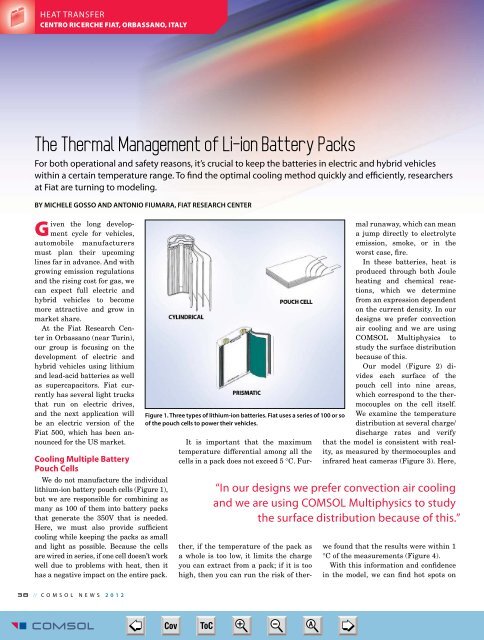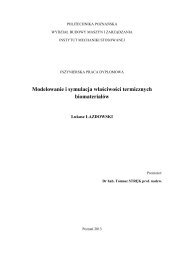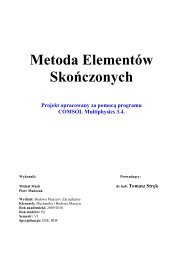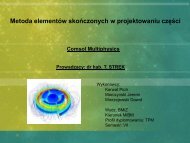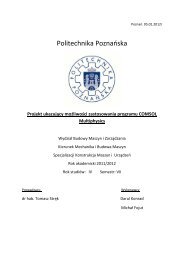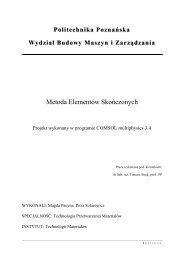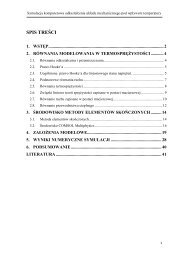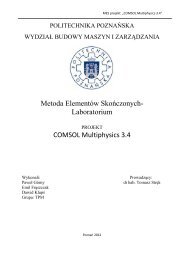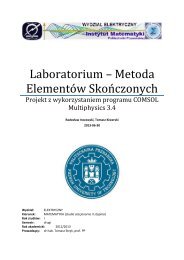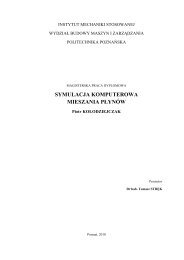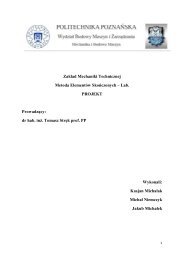COMSOL News
COMSOL News
COMSOL News
Create successful ePaper yourself
Turn your PDF publications into a flip-book with our unique Google optimized e-Paper software.
HEAT TRANSFER<br />
C E N T R O R I C E R C H E F I A T , O R B A S S A N O , I T A L Y<br />
The Thermal Management of Li-ion Battery Packs<br />
For both operational and safety reasons, it’s crucial to keep the batteries in electric and hybrid vehicles<br />
within a certain temperature range. To find the optimal cooling method quickly and efficiently, researchers<br />
at Fiat are turning to modeling.<br />
BY MICHELE GOSSO AND ANTONIO FIUMARA, FIAT RESEARCH CENTER<br />
Given the long development<br />
cycle for vehicles,<br />
automobile manufacturers<br />
must plan their upcoming<br />
lines far in advance. And with<br />
growing emission regulations<br />
and the rising cost for gas, we<br />
can expect full electric and<br />
hybrid vehicles to become<br />
more attractive and grow in<br />
market share.<br />
At the Fiat Research Center<br />
in Orbassano (near Turin),<br />
our group is focusing on the<br />
development of electric and<br />
hybrid vehicles using lithium<br />
and lead-acid batteries as well<br />
as supercapacitors. Fiat currently<br />
has several light trucks<br />
that run on electric drives,<br />
and the next application will<br />
be an electric version of the<br />
Fiat 500, which has been announced<br />
for the US market.<br />
Cooling Multiple Battery<br />
Pouch Cells<br />
We do not manufacture the individual<br />
lithium-ion battery pouch cells (Figure 1),<br />
but we are responsible for combining as<br />
many as 100 of them into battery packs<br />
that generate the 350V that is needed.<br />
Here, we must also provide sufficient<br />
cooling while keeping the packs as small<br />
and light as possible. Because the cells<br />
are wired in series, if one cell doesn’t work<br />
well due to problems with heat, then it<br />
has a negative impact on the entire pack.<br />
Figure 1. Three types of lithium-ion batteries. Fiat uses a series of 100 or so<br />
of the pouch cells to power their vehicles.<br />
It is important that the maximum<br />
temperature differential among all the<br />
cells in a pack does not exceed 5 °C. Further,<br />
if the temperature of the pack as<br />
a whole is too low, it limits the charge<br />
you can extract from a pack; if it is too<br />
high, then you can run the risk of thermal<br />
runaway, which can mean<br />
a jump directly to electrolyte<br />
emission, smoke, or in the<br />
worst case, fire.<br />
In these batteries, heat is<br />
produced through both Joule<br />
heating and chemical reactions,<br />
which we determine<br />
from an expression dependent<br />
on the current density. In our<br />
designs we prefer convection<br />
air cooling and we are using<br />
<strong>COMSOL</strong> Multiphysics to<br />
study the surface distribution<br />
because of this.<br />
Our model (Figure 2) divides<br />
each surface of the<br />
pouch cell into nine areas,<br />
which correspond to the thermocouples<br />
on the cell itself.<br />
We examine the temperature<br />
distribution at several charge/<br />
discharge rates and verify<br />
that the model is consistent with reality,<br />
as measured by thermocouples and<br />
infrared heat cameras (Figure 3). Here,<br />
“In our designs we prefer convection air cooling<br />
and we are using <strong>COMSOL</strong> Multiphysics to study<br />
the surface distribution because of this.”<br />
we found that the results were within 1<br />
°C of the measurements (Figure 4).<br />
With this information and confidence<br />
in the model, we can find hot spots on<br />
3 8 // <strong>COMSOL</strong> NEWS 2 0 1 2<br />
<strong>COMSOL</strong> <strong>News</strong> 2012-17.indd 38<br />
➮<br />
Cov ToC + – A<br />
➭<br />
5/15/12 3:00 PM


